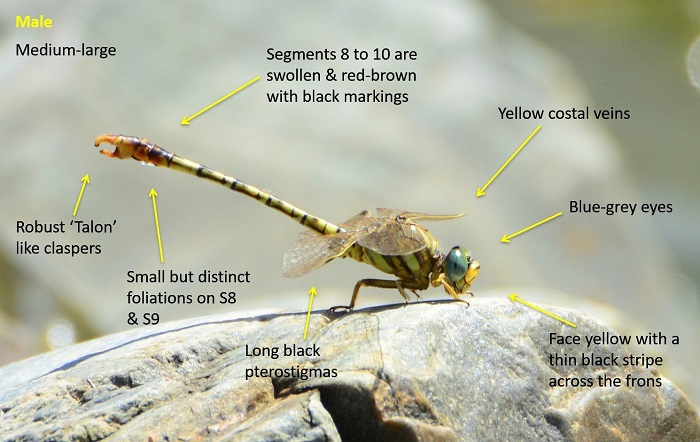View the above photo record (by Alan Manson) in OdonataMAP here.
Find the Clubbed Talontail in the FBIS database (Freshwater Biodiversity Information System) here.
Family Gomphidae
Crenigomphus hartmanni – CLUBBED TALONTAIL
Identification
Medium-large size
Length up to 54mm; Wingspan attains 72mm.
Males are very similar to the rare Crenigomphus cornutus. The Clubbed Talontail is best identified by the small but distinct foliations on segments 8 and 9 of the abdomen. Crenigomphus cornutus lacks these. May also be mistaken for Ceratogomphus pictus (Common Thorntail) at first glance, but the two species have very different clasper structures (males). Females of the two are closer in appearance but those of Crenigomphus hartmanni have brown markings on the last few abdominal segments.
Click here for more details on identification of the Clubbed Talontail.

Mkuze River, KwaZulu-Natal
Photo by Ryan Tippett
Habitat
Inhabits flowing rocky rivers and streams in savanna regions. Prefers shallow, swift flowing sections with pebbles or gravelly substrate. Often found in relatively open areas with tall clumps of grass and bushes.

Photo by Rowan Poortier
Behaviour
Prefers to perch prominently on top of grass or reed stems and bushes. May also perch on rocks close to the water. Flies low and fast over the water or vegetation when hunting or if disturbed. Hunts from a perch and quickly returns to settle again. Frequently found on grass or bushes far from water, especially after breeding or late in the season. Females occur in the same area as the males.
Most active from October to April (see Phenology below).
Status and Conservation
A fairly common but localised species. It is listed as of Least Concern in the IUCN Red List of Threatened Species. The Clubbed Talontail is only found in undisturbed habitats.
Distribution
Crenigomphus hartmanni occurs in East and Southern Africa, from Kenya and Uganda in the north to South Africa. In South Africa it is largely restricted to the Eastern interior, but also found sparsely along the Orange River and at scattered locations in the Eastern and Western Cape.
Below is a map showing the distribution of records for Clubbed Talontail in the OdonataMAP database as at February 2020.

The next map below is an imputed map, produced by an interpolation algorithm, which attempts to generate a full distribution map from the partial information in the map above. This map will be improved by the submission of records to the OdonataMAP section of the Virtual Museum.


Ultimately, we will produce a series of maps for all the odonata species in the region. The current algorithm is a new algorithm. The objective is mainly to produce “smoothed” maps that could go into a field guide for odonata. This basic version of the algorithm (as mapped above) does not make use of “explanatory variables” (e.g. altitude, terrain roughness, presence of freshwater — we will be producing maps that take these variables into account soon). Currently, it only makes use of the OdonataMAP records for the species being mapped, as well as all the other records of all other species. The basic maps are “optimistic” and will generally show ranges to be larger than what they probably are.
These maps use the data in the OdonataMAP section of the Virtual Museum, and also the database assembled by the previous JRS funded project, which was led by Professor Michael Samways and Dr KD Dijkstra.



